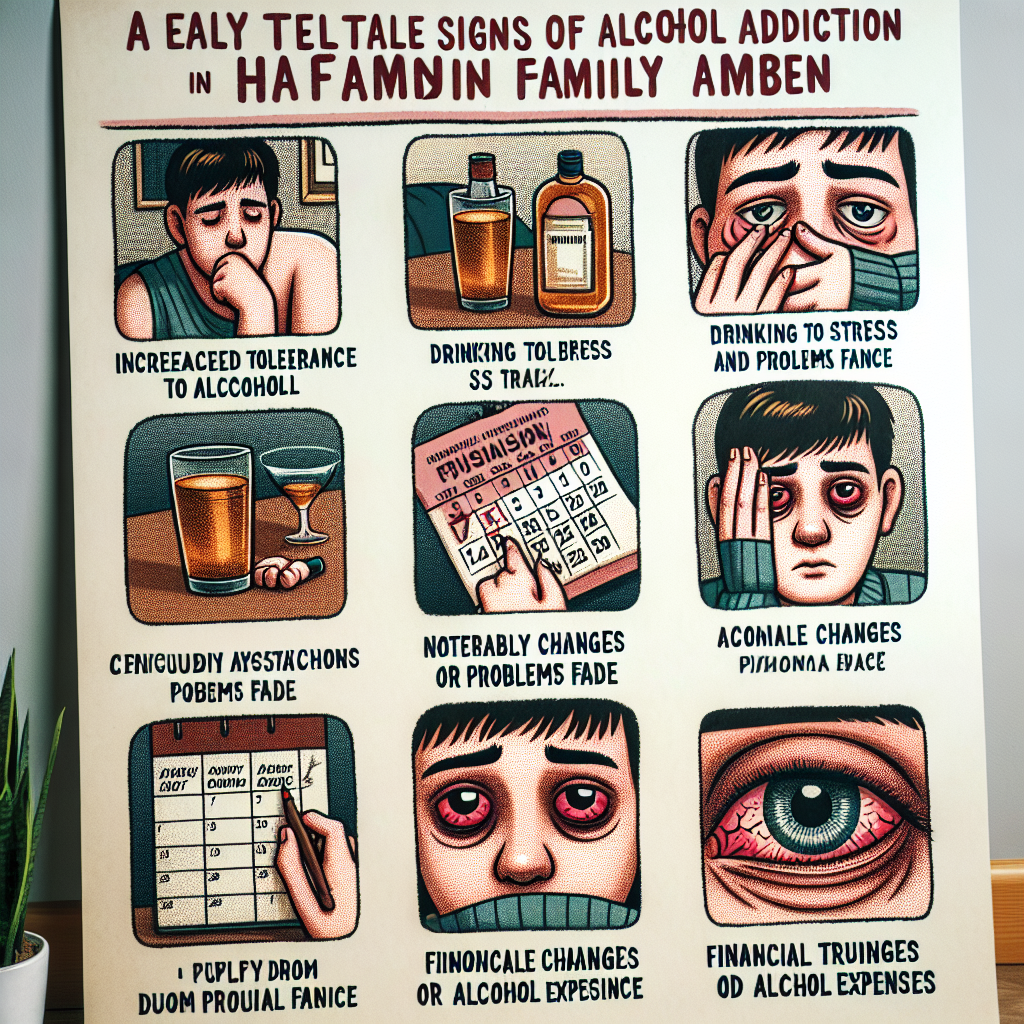-
Table of Contents
- Introduction
- Recognizing Behavioral Changes: Early Signs of Alcohol Addiction in a Family Member
- Physical Symptoms to Watch For: Identifying Alcohol Addiction in Loved Ones
- Emotional Indicators: How to Spot Alcohol Addiction in Family Members
- Social Withdrawal and Isolation: Early Warning Signs of Alcohol Addiction in a Family Member
- Q&A
- Conclusion
“Spotting the Shadows: Early Signs of Alcohol Addiction in a Loved One”
Introduction

Alcohol addiction, also known as alcoholism or alcohol use disorder, can have profound effects on individuals and their families. Recognizing the early signs of alcohol addiction in a family member is crucial for timely intervention and support. These early signs may include noticeable changes in behavior, such as increased secrecy or isolation, neglect of responsibilities at home, work, or school, and frequent mood swings or irritability. Physical symptoms might also be evident, such as unexplained injuries, changes in appearance, or a decline in personal hygiene. Additionally, the individual may exhibit a higher tolerance for alcohol, needing to consume more to achieve the same effects, and may experience withdrawal symptoms when not drinking. Identifying these early indicators can help families address the issue before it escalates, potentially leading to more severe health and social consequences.
Recognizing Behavioral Changes: Early Signs of Alcohol Addiction in a Family Member
Recognizing behavioral changes in a family member can be a challenging yet crucial step in identifying early signs of alcohol addiction. Often, these changes are subtle and can be easily overlooked or mistaken for other issues. However, being vigilant and understanding these early indicators can make a significant difference in addressing the problem before it escalates. One of the first signs to watch for is a noticeable shift in their social habits. A family member who once enjoyed a variety of activities may begin to prioritize drinking over other interests. They might start to decline invitations to events that do not involve alcohol or become increasingly insistent on incorporating alcohol into social gatherings.
In addition to changes in social behavior, you may observe alterations in their daily routines. For instance, they might start drinking at unusual times, such as early in the morning or during work hours. This shift can be accompanied by a growing tolerance to alcohol, where they need to consume more to achieve the same effects. This increased consumption often leads to frequent hangovers, which can result in absenteeism from work or school and a general decline in productivity.
Emotional and psychological changes are also key indicators of potential alcohol addiction. A family member may become more irritable, anxious, or depressed. They might exhibit mood swings that seem disproportionate to the situation at hand. These emotional shifts can strain relationships, leading to conflicts and misunderstandings within the family. It’s important to approach these situations with empathy and understanding, as these emotional changes are often a cry for help.
Another early sign to be aware of is secrecy and defensiveness. A family member struggling with alcohol addiction may go to great lengths to hide their drinking habits. They might lie about how much they are drinking or become defensive when questioned about their alcohol consumption. This secrecy can extend to hiding bottles around the house or drinking alone to avoid detection. Such behavior often stems from a deep sense of shame and denial about their addiction.
Physical changes can also provide clues to a developing alcohol addiction. You might notice weight fluctuations, changes in complexion, or a general decline in personal hygiene. These physical signs, coupled with the behavioral and emotional changes, can paint a clearer picture of the underlying issue. It’s essential to approach these observations with care and concern, rather than judgment, to foster an environment where the family member feels safe to open up.
Financial problems can also arise as a result of alcohol addiction. A family member may start to spend an increasing amount of money on alcohol, leading to financial strain. They might borrow money frequently, neglect bills, or even resort to stealing to fund their drinking habits. This financial instability can add another layer of stress to the family dynamic, making it even more critical to address the issue early on.
Recognizing these early signs of alcohol addiction in a family member is the first step towards helping them seek the support they need. It’s important to approach the situation with compassion and patience, understanding that addiction is a complex and multifaceted issue. By being attentive to these behavioral changes and offering a supportive environment, you can play a pivotal role in their journey towards recovery. Remember, early intervention can make a significant difference, and your support can be a beacon of hope for your loved one.
Physical Symptoms to Watch For: Identifying Alcohol Addiction in Loved Ones
Recognizing the early signs of alcohol addiction in a family member can be a challenging yet crucial step in providing the necessary support and intervention. Physical symptoms often serve as the first indicators that something may be amiss. By paying close attention to these signs, you can help your loved one take the first steps toward recovery and a healthier life.
One of the most noticeable physical symptoms of alcohol addiction is a change in appearance. You may observe that your family member is neglecting their personal hygiene or grooming habits. This can manifest as unkempt hair, poor dental hygiene, or a general lack of cleanliness. These changes often occur because the individual is prioritizing alcohol consumption over self-care.
In addition to changes in appearance, you might notice fluctuations in weight. Alcohol is high in calories and can lead to weight gain, but it can also suppress appetite, resulting in weight loss. These weight changes are often accompanied by a lack of energy and fatigue, as the body struggles to cope with the effects of excessive alcohol consumption. If your loved one seems unusually tired or lethargic, it could be a sign that their body is being taxed by alcohol.
Another physical symptom to watch for is the presence of tremors or shaking, particularly in the hands. This can be a sign of withdrawal, indicating that the body has become dependent on alcohol. Tremors are often most noticeable in the morning or after periods of not drinking, as the body begins to crave alcohol to function normally. Alongside tremors, you may also notice sweating, nausea, and headaches, which are common withdrawal symptoms.
Changes in sleep patterns can also be a red flag. Alcohol can disrupt the natural sleep cycle, leading to insomnia or irregular sleep. Your family member may have difficulty falling asleep, staying asleep, or may experience restless nights. This lack of quality sleep can further exacerbate feelings of fatigue and irritability, creating a vicious cycle that is hard to break.
Moreover, frequent injuries or accidents can be indicative of alcohol addiction. Alcohol impairs coordination and judgment, increasing the likelihood of falls, bruises, or other injuries. If your loved one seems to have an unusual number of unexplained injuries, it may be worth considering whether alcohol is playing a role.
It’s also important to pay attention to changes in behavior that accompany these physical symptoms. Increased secrecy, defensiveness, or irritability when questioned about drinking habits can be telling signs. Your family member may also start to isolate themselves, avoiding social situations where their drinking might be noticed or questioned.
While these physical symptoms can be alarming, it’s essential to approach the situation with compassion and understanding. Confronting a loved one about their alcohol use can be difficult, but it’s a necessary step toward helping them seek the help they need. Express your concerns without judgment, and offer your support in finding professional assistance.
By recognizing these early signs and taking action, you can play a pivotal role in your family member’s journey to recovery. Remember, the road to overcoming alcohol addiction is often long and challenging, but with love, support, and the right resources, it is possible to achieve lasting change and a healthier, happier life.
Emotional Indicators: How to Spot Alcohol Addiction in Family Members
Recognizing the early signs of alcohol addiction in a family member can be a challenging and emotional journey. However, understanding these emotional indicators is crucial for providing the necessary support and intervention. One of the first signs to look out for is a noticeable change in mood and behavior. Family members may observe that the individual becomes increasingly irritable, anxious, or depressed. These mood swings can be sudden and unpredictable, often leaving loved ones feeling confused and concerned.
Another emotional indicator is the presence of secrecy and defensiveness. A family member struggling with alcohol addiction may start to hide their drinking habits, becoming evasive when questioned about their alcohol consumption. They might also become defensive or even hostile when confronted about their drinking, which can be a clear sign that they are aware of the problem but are not ready to acknowledge it.
In addition to mood changes and secrecy, a decline in emotional stability is often evident. The individual may exhibit signs of emotional withdrawal, distancing themselves from family activities and social interactions. This withdrawal can be a coping mechanism to avoid facing the reality of their addiction and the potential judgment from loved ones. Consequently, this emotional distance can create a sense of isolation and loneliness, both for the individual and their family members.
Furthermore, alcohol addiction can lead to a noticeable decrease in motivation and interest in previously enjoyed activities. The individual may lose interest in hobbies, work, or social engagements, preferring instead to spend time alone or with others who share their drinking habits. This lack of motivation can be accompanied by a decline in personal hygiene and self-care, as the addiction takes precedence over other aspects of their life.
Another emotional indicator to be aware of is the presence of guilt and shame. The individual may express feelings of remorse or embarrassment about their drinking, often making promises to cut back or quit altogether. However, these promises are frequently broken, leading to a cycle of guilt and self-blame. This emotional turmoil can be exhausting for both the individual and their family members, who may feel helpless in their attempts to provide support.
It is also important to recognize the impact of alcohol addiction on relationships within the family. The individual may become increasingly argumentative or confrontational, leading to frequent conflicts and tension. These strained relationships can further exacerbate the emotional distress experienced by all family members, creating a toxic environment that hinders recovery efforts.
Despite these challenges, it is essential to approach the situation with empathy and understanding. Recognizing that alcohol addiction is a complex and multifaceted issue can help family members provide the necessary support without judgment. Encouraging open and honest communication is crucial, as it allows the individual to feel heard and understood, which can be a significant step towards seeking help.
In conclusion, spotting the early emotional indicators of alcohol addiction in a family member requires a keen awareness of changes in mood, behavior, and relationships. By approaching the situation with compassion and a willingness to support, family members can play a vital role in helping their loved one navigate the path to recovery. Remember, the journey may be challenging, but with patience and understanding, it is possible to overcome the obstacles and foster a healthier, more supportive environment for everyone involved.
Social Withdrawal and Isolation: Early Warning Signs of Alcohol Addiction in a Family Member
Recognizing the early signs of alcohol addiction in a family member can be challenging, yet it is crucial for timely intervention and support. One of the most telling indicators is social withdrawal and isolation. When a loved one begins to distance themselves from family activities, social gatherings, and even close friends, it may be a red flag signaling the onset of alcohol dependency. This behavioral change often stems from a desire to hide their drinking habits or to avoid judgment and confrontation.
Initially, the individual may make excuses to skip family dinners, outings, or other social events. They might claim to be too tired, busy, or simply not in the mood. Over time, these excuses become more frequent and less convincing. The person may start to spend more time alone, retreating to their room or another secluded space where they can drink without interruption. This isolation can lead to a vicious cycle, as the more they drink, the more they withdraw, and the more they withdraw, the more they drink.
In addition to physical isolation, emotional withdrawal is another early sign of alcohol addiction. The affected individual may become increasingly irritable, defensive, or secretive. Conversations that once flowed easily may now be punctuated with tension and evasiveness. They might avoid eye contact, give short or vague answers, and show little interest in the lives of others. This emotional distance can be particularly painful for family members who feel shut out and helpless.
Moreover, changes in daily routines and responsibilities can also indicate a problem. The person may neglect household chores, personal hygiene, or work commitments. They might frequently call in sick, arrive late, or perform poorly at their job. These lapses are often rationalized or downplayed, but they can have serious consequences, both personally and professionally.
Financial issues can also arise as a result of alcohol addiction. The individual may start to spend an increasing amount of money on alcohol, sometimes at the expense of essential needs like groceries, bills, or rent. They might borrow money from family members or friends, often without a clear explanation for why they need it. This financial strain can add another layer of stress and conflict within the family.
Despite these challenges, it is important to approach the situation with compassion and understanding. Confronting a loved one about their drinking habits can be difficult, but it is a necessary step toward recovery. Expressing concern without judgment, offering support, and encouraging them to seek professional help can make a significant difference. It is also essential for family members to educate themselves about alcohol addiction and to seek support for their own emotional well-being.
In conclusion, social withdrawal and isolation are early warning signs of alcohol addiction that should not be ignored. By recognizing these behaviors and taking proactive steps, families can help their loved ones find the path to recovery. It is a journey that requires patience, empathy, and resilience, but with the right support, it is possible to overcome the challenges of alcohol addiction and rebuild a healthier, more connected family dynamic.
Q&A
1. **Increased Tolerance**: Needing to drink more alcohol to achieve the same effects.
2. **Neglecting Responsibilities**: Failing to fulfill obligations at work, school, or home due to drinking.
3. **Withdrawal Symptoms**: Experiencing physical symptoms like shakiness, sweating, or nausea when not drinking.
4. **Secretive Behavior**: Hiding alcohol consumption or lying about the amount of alcohol consumed.
Conclusion
Early signs of alcohol addiction in a family member may include frequent and excessive drinking, neglecting responsibilities, changes in behavior or personality, withdrawal symptoms when not drinking, increased tolerance to alcohol, secretive behavior about drinking habits, and a noticeable decline in physical health and personal hygiene. Recognizing these signs early can be crucial for seeking timely intervention and support.



